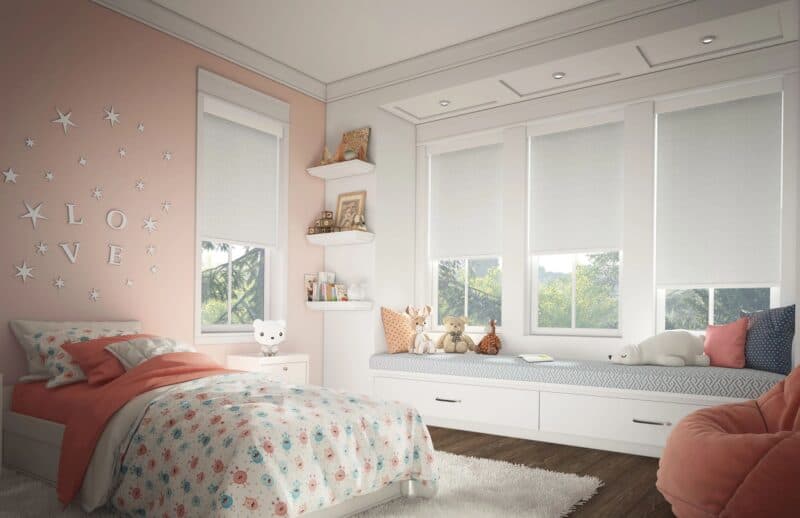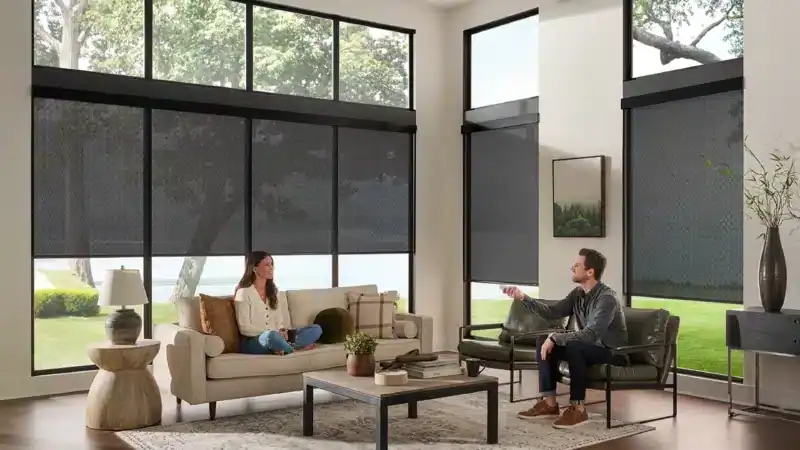Learning smart ways to avoid that mistake becomes crucial as Edmonton homeowners look for effective ways to manage utility costs throughout the year, making understanding how to use window treatments as insulation vital. These treatments do more than just control light and privacy; they create essential barriers against heat transfer, keeping homes warmer in the winter and cooler in the summer. For those seeking premium, energy-efficient solutions right here in the city, exploring options like top-tier cellular shades in Edmonton can significantly impact your home’s thermal performance. We focus on providing solutions that offer both aesthetic appeal and tangible energy savings for residents across our service areas, including those in Quesnell Heights, Edmonton, AB.
Key Insights
- Window treatments act as a secondary layer of insulation, trapping air between the window glass and the fabric/material.
- Cellular or honeycomb shades are specifically engineered with air pockets, making them superior insulators compared to flat window coverings.
- Properly fitted treatments that cover the entire window opening minimize air leakage, maximizing energy retention.
- Investing in energy-efficient window coverings contributes to why you should upgrade your window coverings, including lower energy bills.
- Motorized options, like those featuring advanced PowerView® Automation, allow for precise scheduling to maximize solar heat gain during the day and insulation at night.
Why Cellular Shades Are the Top Choice for Edmonton Homeowners
Cellular Honeycomb Shades offer energy-efficient style with unique honeycomb construction trapping air for insulation in Edmonton & Area at Blind Magic, making them a standout choice for residents battling harsh Alberta weather. The design of these shades creates pockets that trap air, significantly reducing heat transfer through the glass. This structural advantage is why many homeowners choose them when they are creating insulating barriers with shades.
| Feature | Insulation Benefit | Style Consideration |
|---|---|---|
| Honeycomb Structure | Traps air in pockets, reducing heat loss/gain. | Available in single, double, or triple cell designs. |
| Material Density | Thicker fabrics offer higher R-values. | Wide range of textures and colors to match decor. |
| Tight Fit | Minimizes air gaps around the window frame. | Can be paired with Top-Down/Bottom-Up operation for flexible insulation. |
For homeowners in areas like Glenora, Edmonton, AB, who value both aesthetics and performance, cellular shades provide an excellent blend. Furthermore, understanding the science behind energy efficiency at the window confirms that trapped air is the key to thermal regulation.
- The honeycomb structure traps air, creating a thermal barrier against cold winter drafts.
- Double-cell construction, such as found in Applause® Honeycomb Shades in Edmonton, AB, offers superior insulation compared to single-cell options.
- When combined with specialized operating systems like Top-Down/Bottom-Up, homeowners can strategically manage insulation while maintaining desired light levels.
- For those seeking the absolute best thermal performance, options like Duette® Cellular Shades are highly recommended for their effectiveness in lowering energy bills.
Energy Savings Comparison: Cellular Shades vs. Other Blinds
When evaluating window treatments for insulation in Edmonton, it is essential to compare the performance of cellular shades against more traditional options, as the structure of the shade plays a direct role in its insulating capability. We encourage residents across our service areas, such as those in Jasper Park, Edmonton, AB, to consider these differences when planning their upgrades.
| Shade Type | Typical Insulation Value (R-Value Estimate) | Primary Energy Benefit |
|---|---|---|
| Cellular Shades (Double Cell) | Highest | Excellent air trapping; significant reduction in heat transfer. |
| Roman Shades | Moderate | Fabric layers provide some barrier, but less effective than honeycomb. |
| Wood Blinds | Low to Moderate | Relies on material density; less effective at trapping air pockets. |
| Roller Shades (Standard) | Lowest | Flat material offers minimal insulation unless backed by specialized lining. |
Flat window coverings, like standard roller shades or basic horizontal blinds, primarily block radiant heat but do little to stop convection currents near the glass, unlike shades designed with internal structure. For instance, while classic Wood Blinds in Edmonton, AB offer classic style, they do not trap air nearly as effectively as cellular designs. Understanding these differences helps homeowners make informed decisions about why upgrading your window coverings is smart for better home efficiency.
- Cellular shades create multiple layers of insulating air pockets, which is scientifically proven to be more effective than single-layer treatments.
- Thicker fabrics and specialized liners, even in other styles, can improve performance, but the inherent structure of honeycomb shades remains the industry benchmark for insulation.
- By choosing insulating window treatments, you are actively working to reduce the load on your HVAC system, which is a key component of energy conservation.
Installation Process for Cellular Shades in Edmonton
The effectiveness of any insulating window treatment relies heavily on a precise installation, ensuring minimal gaps around the edges where conditioned air can escape or infiltrate, which is why professional service matters for customers in areas like Laurier Heights, Edmonton, AB. When you are looking for Hunter Douglas Blinds in Edmonton, ensuring proper measurement and installation is the final step to realizing energy savings.
- Accurate Measurement: The process begins with precise measurements taken either inside the window frame (for a clean, built-in look) or outside the frame (to ensure maximum coverage and seal).
- Hardware Preparation: Mounting brackets are securely fastened to the window frame or wall, ensuring a solid foundation for the shade assembly.
- Shade Mounting: The cellular shade headrail is snapped securely into the brackets, confirming a snug fit against the window opening.
- Operation Check: Testing the shade mechanism ensures smooth movement and proper closure, which is vital for maintaining the insulating air seal.
- Final Inspection: A final check confirms that the shade sits flush, preventing drafts and maximizing the thermal barrier created by the honeycomb structure.
For homeowners interested in upgrading to motorized options, ensuring the system works seamlessly is also part of the installation, perhaps integrating with PowerView® Automation for automated energy management.
- For maximum insulation, we recommend an outside mount that overlaps the window frame by several inches on all sides to block air movement.
- If you are unsure about the process, learning how to measure your windows for blinds can be helpful before scheduling a professional consultation.
- Proper installation ensures that the shade functions correctly, which is especially important for complex systems like those featuring the Duolite® dual-fabric design.
Customization Options for Cellular Shades (Colors/Textures)
While insulation is a primary concern, Edmonton homeowners also want their energy-saving window treatments to complement their interior design, and cellular shades are available in a vast array of fabrics, colors, and textures. You can explore options that align with current trends, such as moving away from grey, when selecting your perfect shade material.
| Fabric Opacity | Texture/Finish Examples | Ideal Use Case |
|---|---|---|
| Light Filtering | Soft, woven textures; subtle linen looks | Diffusing light while maintaining some insulation. |
| Room Darkening | Dense, opaque materials; often with metallic backing | Bedrooms or media rooms requiring maximum light blockage and insulation. |
| Blackout | Fully opaque material designed to block all light | Areas needing superior thermal retention and total privacy. |
Beyond opacity, the texture of the shade fabric can dramatically alter the room’s ambiance, offering everything from organic looks to sleek modern finishes. For example, homeowners in St. Albert can find shades that mimic the organic feel of Woven Wood Shades in Edmonton, AB but with the added thermal benefit of a cellular backing.
| Cell Size | Insulation Impact | Aesthetic Effect |
|---|---|---|
| 3/8″ Single Cell | Good | Subtle pleating, less visual bulk. |
| 3/4″ Double Cell | Better | More pronounced honeycomb look, excellent air trapping. |
| 1 1/4″ Triple Cell | Best | Maximum insulation, bold texture. |
Conclusion
Utilizing window treatments as insulation is a practical and aesthetically pleasing strategy for managing energy consumption in Edmonton homes year-round. By prioritizing products specifically designed for thermal performance, such as cellular shades, residents can enjoy lower utility bills and increased comfort. We encourage homeowners throughout the city, from Downtown Edmonton, AB to surrounding communities, to consult with experts to find the perfect insulating solution that meets both their energy goals and design preferences.
Faq
| Question | Answer |
|---|---|
| Which window treatment offers the best insulation? | Cellular or honeycomb shades are generally considered the best insulating option due to their unique structure that traps air, creating a thermal barrier. |
| Can motorized blinds help with energy savings? | Yes, motorized shades, especially those with PowerView Gen 3 Help integration, allow homeowners to schedule shade adjustments to maximize passive solar heating or cooling automatically. |
| Are cellular shades difficult to clean? | Generally, no; many modern Hunter Douglas blinds are designed for minimal upkeep, and you can read about the easiest Hunter Douglas blinds to clean for more details. |
| Do I need special shades for large windows? | For expansive windows or sliding doors, vertical treatments like Skyline® Gliding Window Panels in Edmonton, AB can offer good coverage, though wide cellular shades are also available. |
| What is the benefit of Duolite® shades for temperature control? | Hunter Douglas Duolite® in Edmonton, AB combines a light-filtering fabric and a room-darkening fabric in one shade, allowing for dynamic control over insulation and light throughout the day. |





